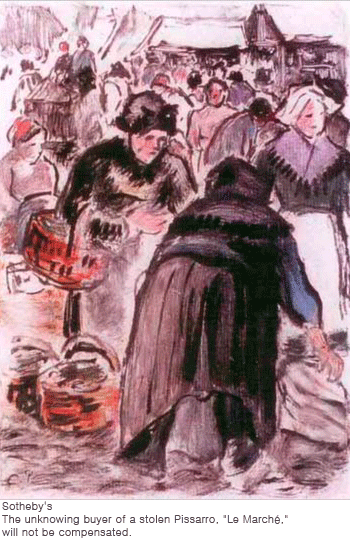Treasured Pissarro Print Turns Into Costly Headache
Sharyl Davis thought she was in luck 25 years ago when she bought a charming market scene by the Impressionist Camille Pissarro from a San Antonio art gallery for $8,500. But since 2003, when she took the print to Sotheby’s to sell, her luck has been running the other way.
As it turns out, 30 years ago the French police reported the work stolen from a museum in Aix-les-Bains. After Ms. Davis tried to sell the print, the United States government seized it as contraband.
Last year a French museum guard with an ostensibly remarkable memory said she recognized the man who consigned the work to the Texas gallery as the thief who had passed by her in 1981 on the day the print was stolen. And then last week a federal appeals court rejected Ms. Davis’s claim that, because she was an innocent owner, she should not have to forfeit the print.
Unlike in the Judgment of Solomon, Judge Gerard E. Lynch of the United States Court of Appeals for the Second Circuit wrote, “neither party has blinked, and we are therefore in the unenviable position of determining who gets the artwork, and who will be left with nothing despite a plausible claim of being unfairly required to bear the loss.”
The three-judge panel also ruled that Ms. Davis could not recover her legal fees. “My $100,000 asset turned into a $100,000 liability — that’s kind of the way I look at it,” Ms. Davis, 67, said by phone from Anthony, Kan., the small town where she now runs a bed-and-breakfast.
The work — a monotype print titled “Le Marché” (“The Market”) — had hung in the small Museé Faure in Aix-les-Bains until the day someone spirited it out of the building. Ms. Davis bought it four years later from the gallery in Texas, J. Adelman Antiques and Art Gallery, which had taken it on consignment from Emil Guelton.
Nearly two decades later, when Ms. Davis’s print appeared in Sotheby’s catalog with an estimate of $60,000 to $80,000, the Art Loss Register contacted the auction house to tell it that the print had been stolen. The French police reopened the case and, according to court papers, showed Mr. Guelton’s photograph, along with others, to a museum guard who had been on duty that day in 1981. She identified him as the thief. The United States government then brought the successful forfeiture claim against Ms. Davis. The print is now in the possession of the United States Immigration and Customs Enforcement agency, and officials could not say when the work might be returned to France.
The museum guard, Jacqueline Rivollet, came to the United States to testify in federal court that she had been a “meter and a half” from Mr. Guelton on the day of the theft. She looked him in the eye as he entered the museum, she testified, and later she saw him run down the stairs and emerge from the stairwell with something under his jacket. The print was discovered missing later that day.
Ms. Davis’s lawyer, Barbara Hoffman of New York, said she did not find Ms. Rivollet’s identification credible because, among other things, the guard had once described the thief as being in his 20s, but Mr. Guelton would have been 40 at the time of the theft. The photograph that Ms. Rivollet was shown to help identify him was taken in 1998 when he was 58, she said.
Mr. Guelton has not been prosecuted for the theft by French authorities, Ms. Hoffman said. “He’s living on a boat in the South of France and has a pied-à-terre in Paris,” Ms. Hoffman said.
The prosecutors who brought the case, from the United States attorney’s office for the Southern District of New York, declined to comment on Mr. Guelton’s legal situation.
Ms. Hoffman said that a more valuable artwork was stolen from the museum the same day as Ms. Davis’s Pissarro, and French officials have not pursued that work with similar gusto. That piece, a Renoir oil painting titled “Buste de Femme,” sold at Sotheby’s in 1987 for $154,000 to a Japanese collector.
Sotheby's said it was looking into the matter.
Ms. Hoffman said that her client did significant due diligence at the time she bought the print, contacting an expert on Pissarro who authenticated it. No one suggested that it might be stolen. But because of the legal parameters of the government’s case, Ms. Hoffman said, she was not allowed to introduce that evidence in court.
Ms. Davis, who is herself an artist as well as an interior designer, said she was very disappointed. “No matter how you look at it, I end up the loser, period, end of story,” she said. She added that she had had displayed the print in all her homes over the years — first in Texas and then in New York, where she lived for over a decade and worked for Ralph Lauren.
“I went through a period of time where I really liked collecting art,” she said. “Fortunately most of my artists are still living, or were” at the time she purchased their work, “so there’s no problem with the title.”
